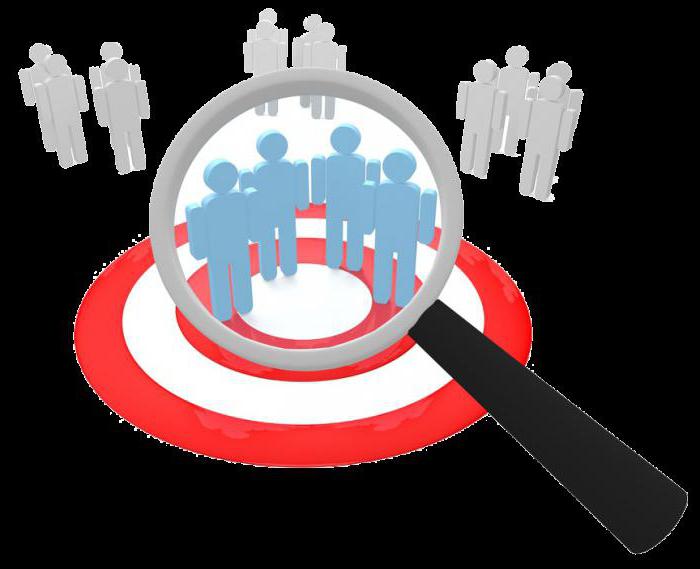The golden rule of any business is to know and understand your client. For the successful promotion of the product it is very important to find out who your target audience is, its wishes, which can interfere with the purchase. This and much more can be found in our article.

What does the term mean?
The target audience is the likely and true buyers of the goods. Under the influence of advertising events, they make a choice in favor of this product.
The target audience is not all people without exception, it refers to a certain part of the market or a separate category of customers for whom this product (service) is intended.
Consider its types
The heart of the target audience is constant consumers of goods (services) who have high purchasing power. They contribute to the growth of product sales and provide a stable and good profit to the business.
So, the following types of target audience are distinguished:
- Main audience and secondary (indirect).
- Wide and narrow.
- Audience by type of target group. Target audience in the field of business (B2B) and individual consumption (B2C).
The first decides to purchase, is its initiator. That is, consumers independently generate demand for the product they need.
An indirect audience takes part in the implementation, gaining secondary importance. Because representatives of this type of target audience may not buy this product at all.

We give examples of the target audience.
Let's consider both types on the example of providing services that entertain children, which will act as the main target audience. Because they will become users. The child wants, for example, to jump on a trampoline, but is not able to pay for this fun. Then they resort to the help of parents who make a purchase (of a product or service) and thereby become an indirect target audience.
In order to accurately determine the main and secondary audience, it is necessary to correctly distribute the roles: who will become the incentive to purchase, who - the person giving the go-ahead for its implementation. Identify the influential side, the buyer and the end user.
We give an example on the acquisition of a baby's dummy. The initiator of the purchase of the product and the person who decides to purchase will be the mother (main audience). This also includes grandmother, who can also act as a stimulus to action and have a significant impact. But the father, who will go to the store for a purchase, will become a representative of an indirect audience. The end user will be a baby who does not belong to any group.
An example of a wide one is lovers of sweet pastries, and adorers of biscuit cakes are a narrow target audience.
We examined examples of the target audience. Now it’s clear how to recognize its types and highlight the essence.
So, to summarize, the target audience is a certain community of people who are most likely to purchase your product. And before we start further discussion of the topic, we will answer one important question.

Do we need to know the target audience in person
Of course, because a complete view of the target audience:
- promotes more effective sales;
- expands and improves the boundaries of the use of advertising tools, which are designed to convey to the consumer information about the product in the best way;
- at the stage of preparing a business plan, it makes it possible to make an accurate assessment of the size of the market, which will serve as the main aspect for a successful start and a profitable investment;
- provides comprehensive information on the possible improvement of existing products and services on the market, on the creation and launch of new ones.
It can be seen from all that the analysis of the target audience is a very important stage in the development of advertising policy, which cannot be put off the shelf. This can cause loss of funds, customers and part of the market. Therefore, it is extremely important to know your buyer in person, take into account the wishes and requirements. And how to determine the target audience?

Definition, steps, methods
Again, the target audience is a community of likely and indirect buyers of a product (service), united by similar parameters and indicators, signs of segmentation. Consider the main ones:
- gender;
- full age;
- whether married
- place of residence;
- specialty;
- education;
- number of family members;
- material wealth.
A model for describing the target audience on the basis of these signs will look like this: women of 30–40 years old, with good earnings and a higher economic education, work in the management of state structures living in a large city with a population of 500 thousand people.
But using general characteristics alone to determine the target audience is not enough. As a result, it turns out to be vague, and it becomes difficult to determine the choice of advertising exposure methods. And you can also get the wrong figure to calculate market opportunities. Therefore, in order to reduce the large-scale number of potential buyers, it is necessary to use other characteristics and relationships between components. This is nothing but segmentation. The more specific the segment within the target audience will be determined, the better will be the result of ongoing promotions aimed at these parts. You can use other criteria.
We characterize the target audience on a psychological basis
Based on these characteristics, it can be described:
- by behavior (gaiety, sociability, leadership, ambitiousness and so on);
- according to life preferences, social and social values, principles (attitude to nature, the struggle for ecology and cleanliness, etc.);
- by life position, way of life, hobby, hobby;
- according to the model of the buyer’s behavior from the moment of desire until the purchase of the product itself;
- by definition of place of purchase of goods, method of use;
- in relation to the price;
- due to choice and action that encourages use.
This is with regard to psychographic characteristics. Consider a description of the target audience in the B2B market.
You can use the following characteristics:
- occupation, product range;
- amount of workers;
- sales for the year;
- scale of production (local, state and international);
- number of branches;
- who makes the decisions;
- sales of products and factors influencing it, for example, seasonal production;
- price policy.
These are the characteristics of the target audience. We note the following: the more criteria we apply, the more specific the portrait of a potential buyer will emerge.
You need to know that there can be several segments. But the target audience also needs to be divided into segments, taking into account certain signs. It is necessary to work with each individual, using the appropriate advertising tools.
Talk about market segmentation
Before you understand who your target audience is, a heterogeneous market needs to be divided into parts.What is segmentation? This is a division of the market into separate groups of customers, which are united by similar parameters, so that you can study their reaction to the proposed product (service) and correctly select the target market segments.
The target market segment is the most effective part for the enterprise, selected for marketing activities.

Consider ways to determine your target audience.
The success of the business will depend on them. There are two research methods:
- Determination of the need for a sold product (service).
- A study of the size of the market in which you are supposed to occupy your niche.
In both cases, you need to answer the following questions:
- Do you know the psychological characteristics of a potential buyer?
- What psychological coloring does the target audience have?
- In what guise does the product appear to the buyer?
- What problems does it fix when purchasing a product?
- What matters when choosing and purchasing a product (service)?
- How did he learn about the product?
Answers will help in deciding how to find the target audience. Moreover, they will make it possible to more easily and efficiently carry out any marketing and advertising developments and promotions.

What else is used to find the target audience
This includes such labor-intensive methods as: various group and individual surveys, questionnaires, interviews, statistics, and so on. It should be borne in mind that the people interviewed in the group say one thing, and in private with the interviewer they answer in a completely different way.
5W method
It was developed by Mark Sherrington, the method is the most popular approach in the study of the target audience.
Its essence is to answer five questions about your potential customers:
- What? - What product will you offer the consumer? Packaging and type of goods.
- Who? - Who will buy your product? Women, men, students, seniors, children.
- Why? - Why will it be of interest to the consumer? Interested in a favorable price or everyday need for this product.
- When? - When will it be bought, when will it become necessary for the consumer? For example, on holidays, weekends, after work, as a gift.
- Where? - Where does the decision to purchase take place and where is it made? Implementation of sales in stationary salons and shopping centers or in online stores.
As a result, it is possible to identify predominant market segments, and its members will become your customers. Analysis of the target audience can be done independently. The main advantage of the method is its simplicity. You do not have to attract professional marketers. And now we will consider step by step how to determine the target audience of the project.

Product analysis
To get started, analyze your product. This is a very important step. For example, a manufacturer of fashionable children's clothing, positioning its product as cheerful, rainbow, perky, convinced that its contingent is children. But in reality, the target audience is their mothers, who want things to be non-marking, practical, comfortable, of high quality. Now the difference is felt. You must always remember the end user.
Collection of information
Gather information about potential buyers. You can also do this yourself, without contacting consulting agencies for help, in the following ways:
- By interviewing loved ones and friends about how the consumer of your product will be presented to them.
- You can create questionnaires on social networks in order to get a direct answer to the question of who is interested in your product.
- Browse similar projects on the Internet, learn who tracks them.
We need to use as many advertising resources as possible. To make the description of your target audience more extensive and significant.
We make a portrait of an ideal customer
Earlier you asked your friends this, now it's time to answer the question yourself: “How do I see an impeccable consumer?” The entire target audience can be represented by one person, having described him in detail. In this case, it is worth focusing on the following characteristics:
- Gender, number of full years, education, marital status.
- Place of residence and work.
- Material wealth.
- Character, attitude, prejudice.
- Hobbies, favorite pastime.
These, of course, are not all basic questions. You can independently supplement the list. You need to try to make the most colorful portrait of a potential buyer. Do not dwell on one description, because the adherents of your product may be several target audiences at once.
for example
You sell baby products. Your target (main) audience is mothers of babies, the age of the last 0–5 years. This is a woman aged 20–40 years, married. Active, full of energy and energy, she devotes all her free time to the child, walking with him in the park, in the city, in shopping centers. Together they attend development courses and sections. Mom drives a car, tries to keep herself in perfect shape. He is an active user of social networks in order to keep up with fashion trends and keep abreast of all the news and trends. The main income is the spouse's earnings; the general financial situation is not bad. She is passionate about your product, the main thing that excites her is comfort, positive characteristics and new trends.
And what target audiences still exist
The second category is close relatives and friends of young mothers. They also take a direct part in raising the baby, give him surprises for his birthday and just like that. They are active users of social networks, make purchases through online stores. Choose acceptable and convenient services.
The third target category is women in a position who are already browsing the online pages of virtual catalogs of trendy online stores and boutiques. They have a lot of free time, which allows them to view news feeds of social networks, express their own opinions and leave feedback about the product they are viewing.
The target category or group is a part of your target audience to which the promotion will be directed.
After a detailed analysis of the target audience, you will create a clear image of your consumer. And now it’s clear who should focus more on what is the most effective way to approach them. Or maybe you decide to upgrade your product to meet the great demands of customers. Be that as it may, your target audience will open to you.
And a few tips in the end
After determining the core of the target audience, do not lose sight of the secondary audience, which may also be a consumer of this product. It is necessary to analyze the statistics of visits to your site or pages on social networks. Upgrade information data, keep up with the times, be aware of emerging innovations, be on a par with your customers, ahead of them, warning experiences and wishes.
We will repeat what needs to be done to most accurately identify our customers:
- First, we determine the final consumer.
- By any available methods we collect all the necessary information about potential buyers.
- We create the perfect portrait of the consumer in each target group.
- We view, research and supplement our project, we are in the light of new events.
The main thing is perseverance and desire. You must always go forward and improve yourself.